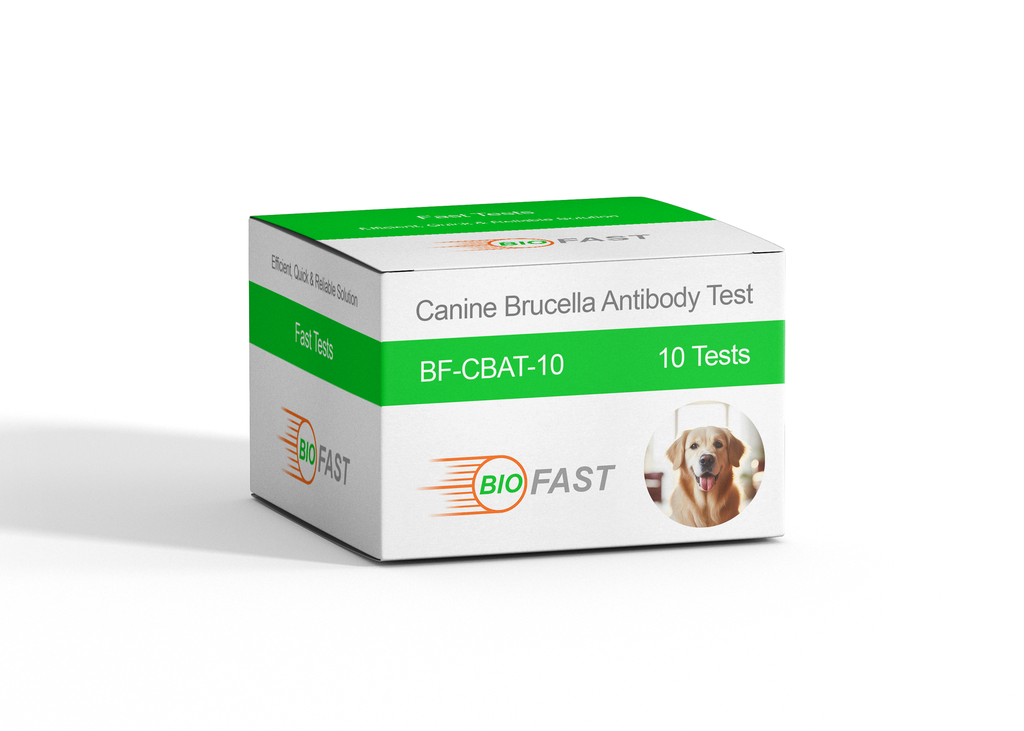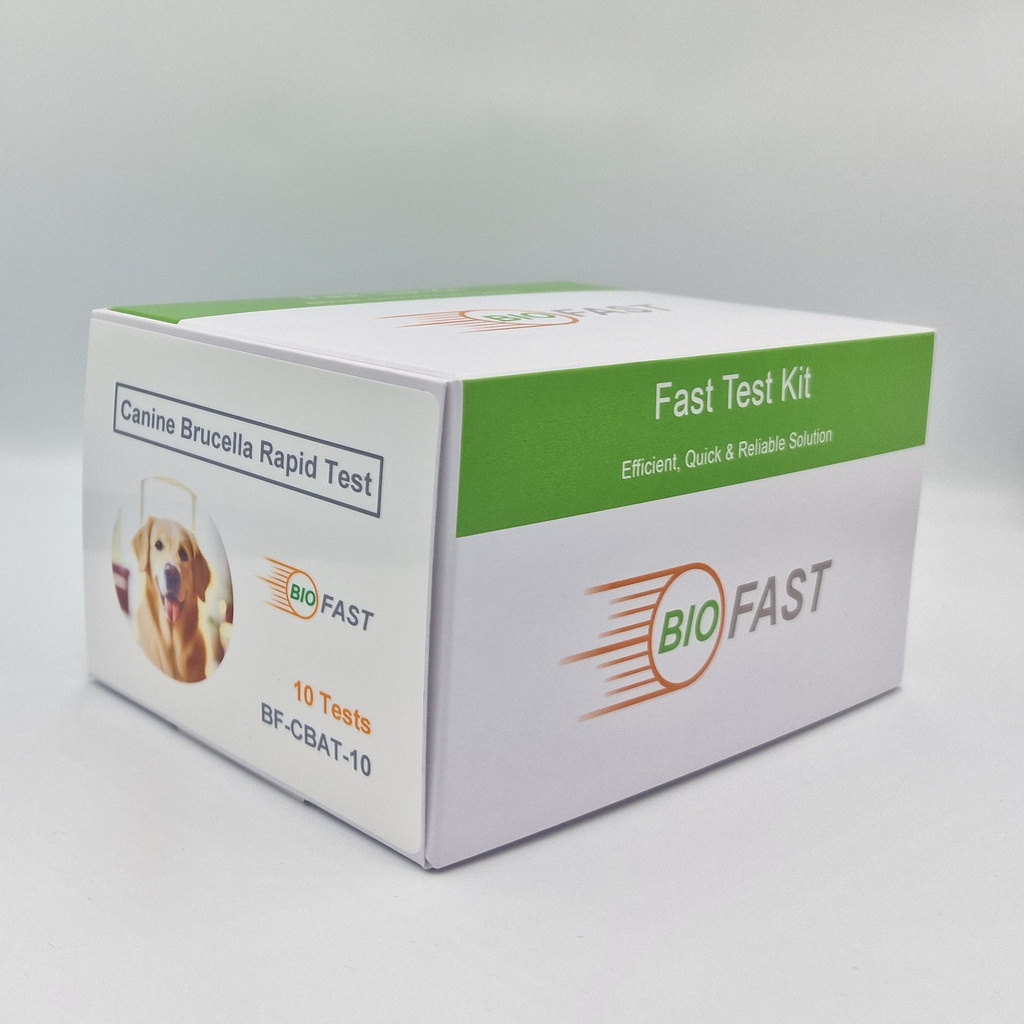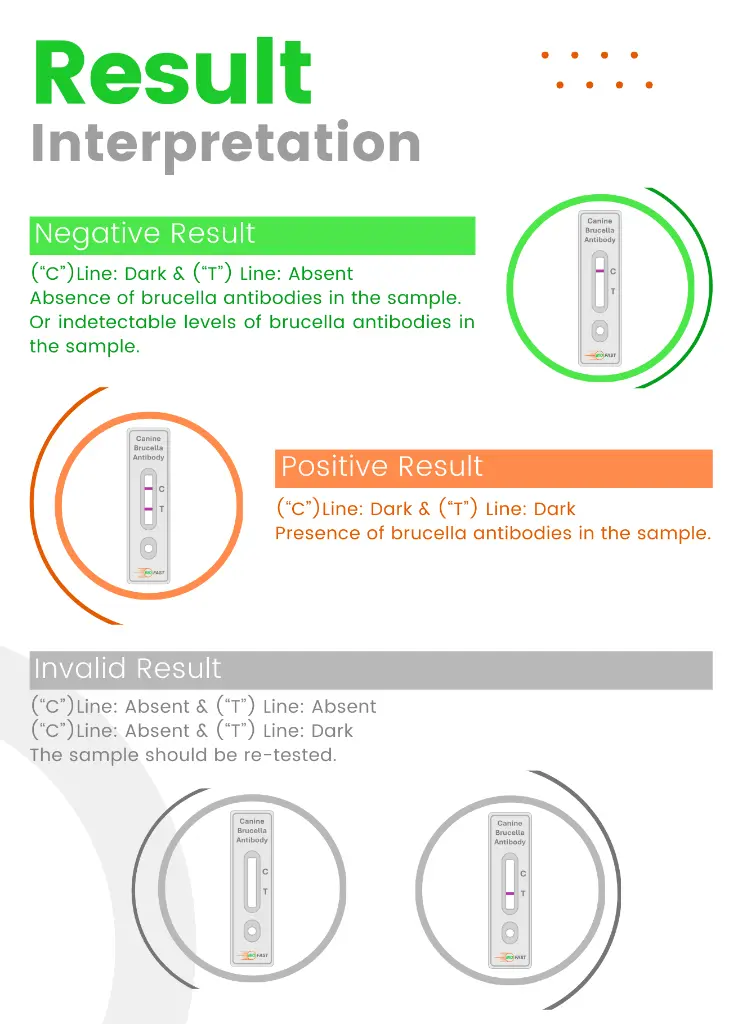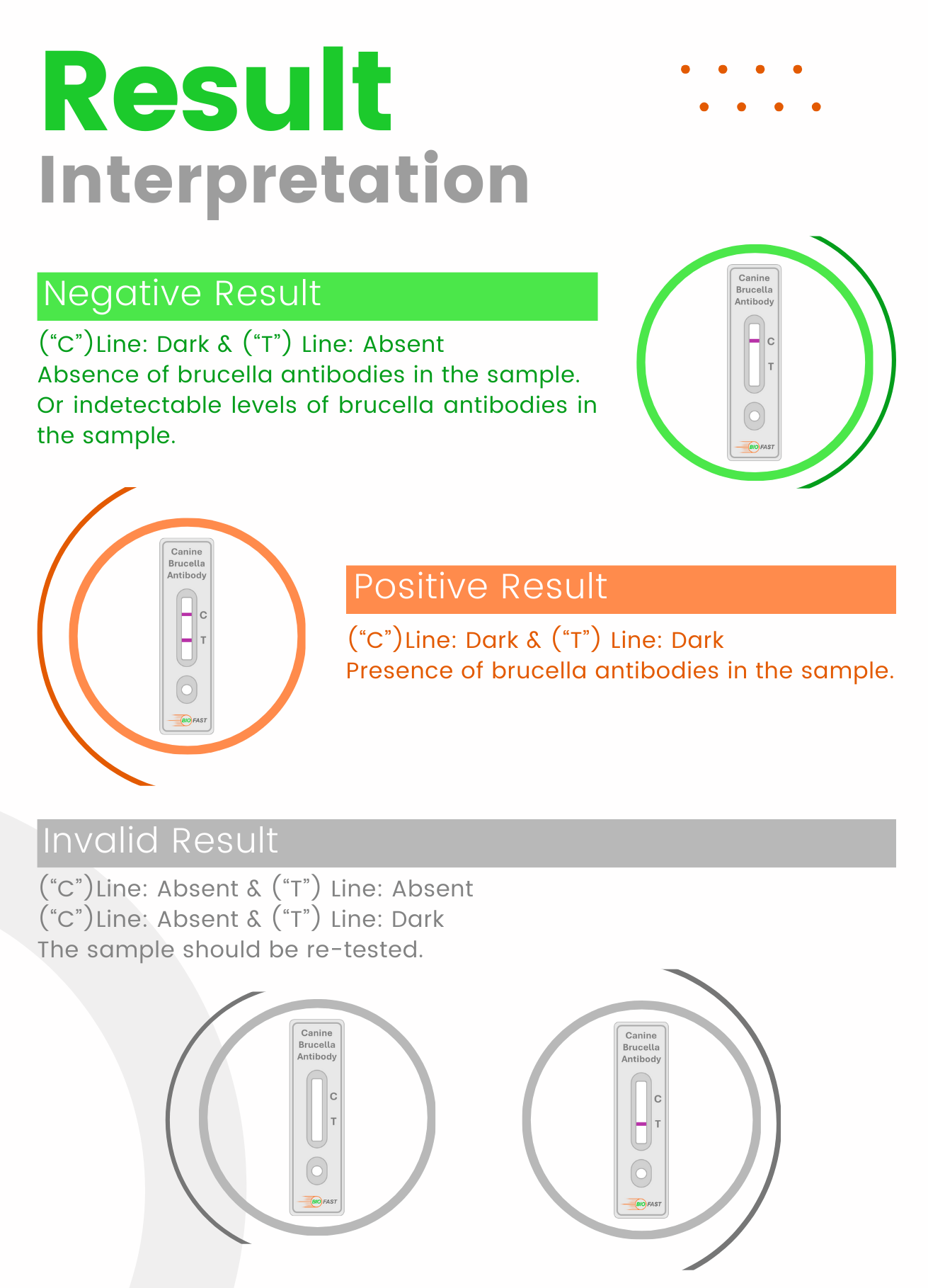Canine Brucella Antibody Rapid Test
At Bio-FAST, we offer the Canine Brucella Antibody Rapid Test, a cutting-edge solution designed to swiftly and accurately detect Brucella in dogs. Our test provides veterinarians and pet owners with a reliable method for early identification, allowing prompt intervention and care.
KEY FEATURES:
- Rapid Results: Obtain results within minutes, enabling quick decision-making for effective treatment.
- High Accuracy: Our test boasts high sensitivity and specificity, ensuring dependable outcomes.
- Ease of Use: Simple testing procedure that can be conducted by veterinary professionals with minimal training.
- Reliable Detection: Detects Brucella antibodies efficiently, aiding in the early diagnosis of infections.
- Cost-effective: An affordable screening option without compromising accuracy or reliability.
BENEFITS:
- Early Detection: Identify Brucella infections in dogs early, enhancing treatment efficacy.
- Peace of Mind: Provide pet owners with quick and reliable results, alleviating concerns about their pet's health.
- Improved Veterinary Care: Empower veterinarians with a rapid diagnostic tool for timely intervention.
HOW IT WORKS:
The Canine Brucella Antibody Rapid Test is a user-friendly kit that requires a small blood sample. The test is based on lateral flow chromatography and detects Brucella antibodies, providing clear results in just a few minutes. Its simplicity and accuracy make it an invaluable tool for veterinary clinics, shelters, and breeders concerned about Brucella infection.
USAGE:
This test is recommended for routine screenings, especially for dogs in breeding programs, those showing symptoms of Brucella infection, or in regions where Brucella prevalence is a concern. Consult with a veterinarian for proper interpretation of results and follow-up care.
MATERIALS REQUIRED:
- Canine Brucella Antibody Rapid Test kit
- Sample collection device (e.g., lancet, syringe)
- Sterile swabs or wipes (alcohol wipes)
- Timer or clock
TEST PROCEDURE:
Preparation:
- Ensure the test kit is at room temperature (15-30°C / 59-86°F) before use.
- Label the test device with the identification details of the dog.
Sample Collection:
- Use a sterile collection device (lancet or syringe) to collect a small blood sample from the dog's vein or via a quick prick on the dog's ear vein.
- Apply pressure to the site to stop bleeding and use a sterile swab or wipe to clean the area.
Test Application:
- Remove the Canine Brucella Antibody Rapid Test cassette from its sealed pouch just before use.
- Place the cassette on a flat, clean surface.
Adding the Sample:
- Using a pipette or provided dropper, add 2-3 drops of the collected blood sample to the sample well (S) of the test cassette.
Reading Results:
- Set a timer or clock according to the specified test duration (usually indicated in the kit's instructions).
- Read the results within the specified time frame mentioned in the instructions (usually 5-10 minutes).
Interpretation:
- A visible line in the control region (C) indicates that the test is functioning correctly.
- Interpret the presence or absence of a line in the test region (T). A visible line in both the control (C) and test (T) regions indicates a positive result for Brucella antibodies. A line only in the control region (C) signifies a negative result.
Result Documentation:
- Record the results accurately, including the date and time of the test, identification details of the dog, and the interpretation of the test (positive or negative).
Disposal:
- Properly dispose of used test components according to local regulations for biohazardous waste.
RESULT INTERPRETATION:
Negative Result:
- Control Line (C): A visible line in the control region (C) indicates the test has worked properly.
- Test Line (T): No line appears in the test region (T), indicating the absence of Brucella antibodies. This configuration signifies a negative result for Brucella antibodies.
Positive Result:
- Control Line (C): A visible line in the control region (C) confirms the test's functionality.
- Test Line (T): A visible line appears in both the control (C) and test (T) regions, indicating the presence of Brucella antibodies. This configuration signifies a positive result for Brucella antibodies.
Invalid Result:
- No Control Line (C): If there's no visible line in the control region (C), the test is considered invalid. This may suggest an error in the testing process or a faulty test kit.
NOTE:
- Follow the instructions precisely from the insert included in the kit.
- Results should be interpreted by a qualified veterinarian familiar with the test and Brucella infections in dogs.
Canine Brucellosis FAQs
What is canine brucellosis?
- Canine brucellosis is an infectious disease caused by the bacterium Brucella canis. It primarily affects the reproductive organs of dogs, leading to infertility, abortions, and other reproductive issues. It can also cause other systemic symptoms and is zoonotic, meaning it can be transmitted to humans.
How is canine brucellosis transmitted?
- The disease is primarily spread through contact with bodily fluids from infected dogs, including blood, urine, semen, and vaginal discharges. It can also be transmitted through breeding, aborted fetuses, or contaminated food and water.
What are the symptoms of canine brucellosis?
- Common symptoms include reproductive issues such as infertility, spontaneous abortions, and stillbirths. Other signs can include lethargy, lameness, swollen lymph nodes, and chronic pain. Some dogs may show no symptoms but still carry the disease.
How is canine brucellosis diagnosed?
- Diagnosis is typically made through blood tests that detect antibodies against Brucella canis. Additional tests, such as bacterial culture and polymerase chain reaction (PCR), can be used to confirm the diagnosis.
Can canine brucellosis be treated?
- Treatment for canine brucellosis is challenging and often involves a combination of antibiotics over an extended period. Despite treatment, some dogs may remain carriers of the bacteria. Infected dogs are often recommended to be neutered or spayed to prevent the spread of the disease.
Is canine brucellosis contagious to humans?
- Yes, Brucella canis is zoonotic and can infect humans. People in close contact with infected dogs, such as breeders, veterinarians, and pet owners, are at higher risk. Human infection can cause flu-like symptoms, and in severe cases, more serious health issues.
How can the spread of canine brucellosis be prevented?
- Prevention includes regular screening and testing of breeding dogs, practicing good hygiene, and isolating infected animals. It is also important to avoid breeding dogs that have tested positive for Brucella canis.
What should I do if my dog is diagnosed with canine brucellosis?
- Consult your veterinarian for a comprehensive treatment plan. Follow their guidance on managing the infection, which may include isolation from other animals, medication, and potential lifestyle adjustments. Inform anyone who has had contact with your dog, including breeders and other pet owners.
Can canine brucellosis be prevented through vaccination?
- Currently, there is no vaccine available for Brucella canis. Prevention relies on screening, testing, and good hygiene practices to reduce the risk of infection.
Are certain breeds more susceptible to canine brucellosis?
- Canine brucellosis can affect any breed of dog. However, it is more commonly seen in breeding kennels and among dogs with close contact with other dogs, such as in shelters or dog shows. Regular screening in such environments is crucial.
Canine Brucella Antibody Rapid Test FAQs
What is the Canine Brucella Antibody Rapid Test?
- The Canine Brucella Antibody Rapid Test is a diagnostic tool used to detect antibodies against Brucella canis in dogs. It is a quick and reliable method to identify exposure to the bacteria, which can cause brucellosis in canines.
Why is it important to test for Brucella canis in dogs?
- Brucella canis is a bacterial infection that can lead to reproductive issues, lameness, and other health problems in dogs. It is also zoonotic, meaning it can be transmitted to humans. Early detection helps in managing and controlling the spread of the disease.
How is the Canine Brucella Antibody Rapid Test performed?
- The test is performed by taking a small blood sample from the dog, which is then applied to the test device. Results are typically available within 10-15 minutes, making it a rapid and convenient option for veterinarians.
What do the results of the test mean?
- A positive result indicates the presence of antibodies against Brucella canis, suggesting that the dog has been exposed to the bacteria. A negative result means no antibodies were detected, implying no exposure or an early stage of infection where antibodies are not yet detectable.
Can a dog test positive for Brucella canis but not show any symptoms?
- Yes, some dogs may be asymptomatic carriers of Brucella canis, meaning they can test positive for antibodies without showing clinical signs of the disease. This makes regular screening important, especially in breeding or multi-dog environments.
How reliable is the Canine Brucella Antibody Rapid Test?
- The test is highly reliable, with sensitivity and specificity values generally above 90%. However, confirmatory testing using additional methods like PCR or culture is recommended for positive cases.
Can the test differentiate between active and past infections?
- The Canine Brucella Antibody Rapid Test detects antibodies, which indicates exposure but cannot distinguish between active and past infections. Further testing and clinical evaluation are necessary to determine the infection status.
Is there any preparation required before testing?
- No special preparation is required for the dog before the test. However, it is important to follow the test kit instructions carefully to ensure accurate results.
What should I do if my dog tests positive for Brucella canis?
- If your dog tests positive, consult with your veterinarian for a confirmatory test and discuss the appropriate treatment and management plan. It's also important to take measures to prevent the spread of the infection to other animals and humans.
How often should dogs be tested for Brucella canis?
- The frequency of testing depends on the dog's risk factors. Breeding dogs, those in shelters, or in multi-dog households should be tested regularly, typically every 6-12 months. Consult with your veterinarian to determine an appropriate testing schedule for your dog.









